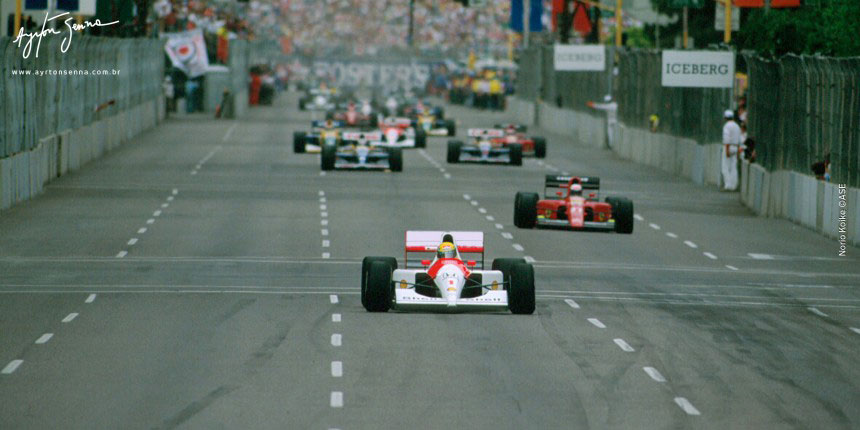Formula 1 has been gaining increasing visibility in the U.S., with three races now part of the calendar — and a renewed audience embracing the sport’s new era. Among Generation Z fans, six out of ten say they connect with the Brazilian driver, according to a survey conducted in April 2025.
In the U.S., Senna confirmed his supremacy: over six seasons, between 1986 and 1991, he won five of the six Formula 1 Grands Prix held in the country. Unlike his legendary Monaco record, this dominance came across two different venues — Detroit (1986 to 1988) and Phoenix (1990 and 1991). Moreover, Senna triumphed in America with two different teams: his first two wins in Detroit with Lotus, and the next three with McLaren.
The only exception during this six-year span came at the 1989 U.S. Grand Prix, the first held in Phoenix. Senna took pole position, set the fastest lap, and led comfortably until his McLaren suffered electrical issues. Forced to retire, the win went to his teammate, Alain Prost.
Senna’s “King of America” legacy began with one of his most memorable victories. At the 1986 U.S. Grand Prix in Detroit, for the first time in F1, he performed what would become an iconic celebration — waving the Brazilian flag on his victory lap.
That gesture carried deep emotion: it was Senna’s way of bringing joy to Brazilians after the national soccer team had been eliminated from the 1986 World Cup the day before, losing to France in a penalty shootout. Senna recalled that special moment later that year in an interview with brazilian TV show Roda Viva:
“The day before, I had just taken pole, and when I got back to the garage, Brazil was winning 1–0 against France. I went straight to the hotel to watch the game. My designer was French, my mechanics were French… so after Brazil lost, of course, they teased me a bit. Fortunately, I won the race the next day. There were many Brazilians there, and after the race — I was exhausted, it was a tough race — I saw a fan behind the fence with a Brazilian flag. It was pure instinct. I signaled to the marshal, who didn’t understand at first, but then he went and got the flag for me. I was able to drive the entire lap holding it. It was very special,” Senna said.

Like Monaco, the Detroit street circuit demanded absolute precision — one mistake meant immediate retirement. In 1987, Senna started from second and won again with Lotus, now in its new yellow livery — marking the first Formula 1 victory for a car equipped with active suspension.
Senna’s dominance on American tracks continued after his move to McLaren, earning a third consecutive victory in Detroit — a record that would stand forever, as the venue was dropped from the calendar the following year. His stunning 1988 performance, finishing 38 seconds ahead of Prost and lapping third-place Thierry Boutsen, played a crucial role in securing his first Formula 1 World Championship — with a then-unprecedented eight wins in a single season.
F1 returned to the United States in 1989, now on the streets of Phoenix, Arizona. The race proved physically and mechanically demanding, causing several retirements — including Senna’s, despite once again setting pole, fastest lap, and leading much of the race. But after that setback, the Brazilian bounced back with two straight wins, coinciding with the start of his back-to-back title campaigns.
In 1990, starting fifth on the grid, Senna delivered an aggressive and masterful drive to the front. The race also featured one of his most thrilling duels — against the young Frenchman Jean Alesi, driving for the surprising Tyrrell team. Senna overtook Alesi, who immediately fought back to retake the lead. Senna then executed a perfect counterattack, closing the door firmly to secure the top spot.

That race opened the 1990 season, which ended with Senna’s second world title. The story repeated itself in 1991, when Senna once again won the season opener in Phoenix, this time starting from pole position.
That victory also launched an incredible run — four straight wins in the first four races of the season, a record at the time. Among them was his emotional home victory at the Brazilian Grand Prix, achieved despite being stuck in sixth gear during the final laps at Interlagos.
King of America
With five victories in six years, Ayrton Senna cemented his place as Formula 1’s “King of America,” a title that remained unchallenged after 1992, when the U.S. Grand Prix was dropped from the calendar. F1 would only return in 2000, with the new Indianapolis road course inside the iconic oval.
In late 1992, Senna even tested an IndyCar at Firebird Raceway in Arizona, in a session organized by Emerson Fittipaldi and his Penske team. In an interview with Senna TV, team owner Roger Penske expressed his deep admiration for the Brazilian and said it would have been incredible to see Senna compete at the Indianapolis 500.
With a new generation of fans discovering Formula 1 through global hits like Drive to Survive and JOURNEY, both on Netflix, Ayrton Senna’s reign in America will continue to be celebrated for years to come by countless motorsport enthusiasts.
Ayrton Senna’s US victories nos
June 22, 1986 – Detroit (Started from pole)
June 21, 1987 – Detroit (Started 2nd)
June 19, 1988 – Detroit (Started from pole)
March 11, 1990 – Phoenix (Started 5th)
March 10, 1991 – Phoenix (Started from pole)
By Rodrigo França, for website Senna.com, from Austin, Texas.

